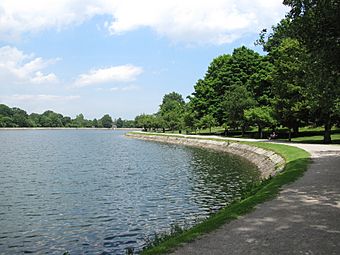Reservoir Park (Massachusetts) facts for kids
|
Reservoir Park
|
|

Brookline Reservoir
|
|
| Location | Boylston St., Brookline, Massachusetts |
|---|---|
| Built | 1848 |
| Architect | City of Boston; French, Alexis |
| MPS | Brookline MRA |
| NRHP reference No. | 85003307, 15000278 |
Quick facts for kids Significant dates |
|
| Added to NRHP | October 17, 1985 |
| Designated NHL | 2015-02-27 |
Reservoir Park is a cool historic park located on Boylston Street in Brookline, Massachusetts. Its main feature is the Brookline Reservoir. This reservoir used to be a very important part of the public water supply for the nearby city of Boston.
The reservoir was built in 1848. It was the main end point for the Cochituate Aqueduct. This aqueduct was like a big water pipe that brought water from Lake Cochituate. Lake Cochituate is located in the western suburbs of Boston.
Contents
Exploring Brookline Reservoir Park
The Brookline Reservoir covers about 21.1 acres (8.5 hectares) of land. It has a shape that looks a bit like a kidney bean. There is a nice gravel path that goes all the way around the edge of the reservoir. This path is great for walking or jogging.
The park has clear boundaries. To the north, it's bordered by Boylston Street, which is also Massachusetts Route 9. Lee Street is on its west side. Dudley Street forms the southern border. On the east, you'll find Warren and Walnut Streets.
The Park's Special Buildings: Gatehouses
There are two interesting buildings in Reservoir Park. They are called gatehouses.
The Influent Gatehouse
At the western end of the reservoir, you'll find the Influent Gatehouse. This building was the end of the Cochituate Aqueduct. It's a simple, useful building made from cut granite stones. It measures about 11 feet (3.4 meters) by 12 feet (3.7 meters) and is 11 feet tall. Inside, there's equipment that helped control the flow of water from the aqueduct into the reservoir.
The Principal Gatehouse
The Principal Gatehouse is much more detailed and fancy. It's located at the northeastern end of the reservoir. This building has two stories and is partly hidden in the ground. Like the other gatehouse, it's built from cut granite. However, this one was designed to be a public space.
Its main front looks like a mix of old styles. It has parts that remind you of Renaissance Revival architecture and a front that looks like an ancient Greek temple. The corners of the building have special stone blocks called quoins. These quoins are a lighter color than the rest of the building. There's also a line of this lighter stone between the two floors.
The roof of the Principal Gatehouse has a triangular end called a pediment. This pediment is decorated with a pattern called dentil stonework. The front of the building has three sections. The main entrance is in the middle on the lower level. This entrance is set back behind an arch. Round columns stand next to the arch, holding up a decorative beam. Small, tall, round-arch windows are on each side of the entrance. The upper level has three larger, equally sized round-arch windows. This upper part of the building also has a front that faces the water, which also has three round-arch windows.
Inside the Principal Gatehouse
Because the Principal Gatehouse was meant for the public, its inside was also nicely finished. The walls were plastered smooth. There were stairs made of wrought iron. These stairs led to a platform where people could look out at the water.
These wrought iron stairs are thought to be the oldest ones in the United States that were made for public use. (Older stairs exist in lighthouses and prisons, and in other countries.) The building's roof is also special. It's believed to be the only old roof still standing that is supported by wrought iron trusses.
A Protected Historic Site
Reservoir Park was added to the National Register of Historic Places in 1985. This means it's a place that is important to the history of the United States.
Later, in 2015, the Principal Gatehouse was given an even higher honor. It was named a National Historic Landmark. This recognizes its special architecture and how well it has been kept. It's considered the best-preserved part of the old Cochituate Aqueduct system.



